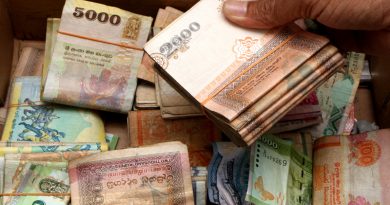Sri Lanka faces risks of debt distress: Global Think Tank
By Nishel Fernando
Sri Lanka’s debt owed to China to increase to 17 per cent from the current 12 per cent due to the Belt and Road Initiative (BRI) projects raising risks of debt distress significantly, according to a recent Report released by the Center for Global Development, a US- based international think tank.
The Report found that Sri Lanka was among the 15 countries out of 68 countries in the BRI lending pipeline that could suffer from debt distress, due to future BRI-related financing. However, Sri Lanka wasn’t included in the top eight high risk countries which include Sri Lanka’s South Asian neighbours – Pakistan and the Maldives.
According to available data, Sri Lanka owed China $8 billion in debt. However, the authors of the Report noted that it was difficult to assess the present value of the debt owed by a country to China as China doesn’t report its foreign lending in a systematic or transparent manner unlike other governmental and multinational creditors.
The authors emphasized that China might be pushing projects under the BRI initiative which adds new debt vulnerabilities in developing countries and risks growth setbacks, rather than introducing projects which provides spurring growth and economic opportunity.
“We conclude that there are some countries, most of whom are small and relatively poor, that face a significantly increased risk of a sovereign debt default if planned BRI projects are implemented in an expeditious manner and financed with sovereign loans or guarantees”, the authors stressed.
Minister of Special Assignments, Dr. Sarath Amanugama last year announced that China was willing to provide an estimated of additional $24 billion as part of BRI.
The Report stated that the Sri Lankan Government was likely to agree to additional BRI-related financial commitments, however, their size was likely to be tempered by the Hambantota Port experience.
The study recommends that MDBs such as WB should work towards a more detailed agreement with the Chinese government, when it comes to lending standards that will apply to any BRI project while introducing additional mechanisms to agree to lending standards.
According to the Report, Pakistan is by far the largest country at high risk, with China reportedly financing about 80 per cent of its estimated US$62 billion in additional debt.
China also has been attempting to draw commercial banks and private capital for funding and lending facilities in BRI. The Chairman of Standard Chartered Bank, Jose Vinals recently cautioned that it was necessary for international commercial banks to make sure the commercial and financial viability of project spending.
Sri Lanka has one of the highest public debts as a percentage of the GDP, which stands at 79.3 per cent by 2016. The country also faces external sovereign bond maturities worth $9.65 billion starting from 2019 to 2023 and from 2025 to 2027 with a record $4 billion debt repayment due in 2019. The situation is further worsened by maturing bonds of commercial banks and SriLankan Airlines from 2017 to 2019 worth $ 1.8 billion or 12 per cent of GDP, according to the WB.
The Chinese government has announced an investment of $8 trillion for BRI, spanning across 68 countries for vast network of transportation, energy and telecommunications infrastructure linking Europe, Africa, and Asia.
BRI spans at least 68 countries with an announced investment as high as $8 trillion for a vast network of transportation, energy, and telecommunications infrastructure linking Europe, Africa, and Asia.1 It is an infrastructure financing initiative for a large part of the global economy that will also serve key economic, foreign policy and security objectives for the Chinese government.
The Report found that Sri Lanka was among the 15 countries out of 68 countries in the BRI lending pipeline that could suffer from debt distress, due to future BRI-related financing. However, Sri Lanka wasn’t included in the top eight high risk countries which include Sri Lanka’s South Asian neighbours – Pakistan and the Maldives.
According to available data, Sri Lanka owed China $8 billion in debt. However, the authors of the Report noted that it was difficult to assess the present value of the debt owed by a country to China as China doesn’t report its foreign lending in a systematic or transparent manner unlike other governmental and multinational creditors.
The authors emphasized that China might be pushing projects under the BRI initiative which adds new debt vulnerabilities in developing countries and risks growth setbacks, rather than introducing projects which provides spurring growth and economic opportunity.
“We conclude that there are some countries, most of whom are small and relatively poor, that face a significantly increased risk of a sovereign debt default if planned BRI projects are implemented in an expeditious manner and financed with sovereign loans or guarantees”, the authors stressed.
Minister of Special Assignments, Dr. Sarath Amunugama last year announced that China was willing to provide an estimated of additional $24 billion as part of BRI.
The Report stated that the Sri Lankan Government was likely to agree to additional BRI-related financial commitments, however, their size was likely to be tempered by the Hambantota Port experience.
The study recommends that MDBs such as WB should work towards a more detailed agreement with the Chinese Government, when it comes to lending standards that will apply to any BRI project while introducing additional mechanisms to agree to lending standards.
According to the Report, Pakistan is by far the largest country at high risk, with China reportedly financing about 80 per cent of its estimated US$ 62 billion in additional debt.
China also has been attempting to draw commercial banks and private capital for funding and lending facilities in BRI. The Chairman of Standard Chartered Bank, Jose Vinals recently cautioned that it was necessary for international commercial banks to make sure the commercial and financial viability of project spending.
Sri Lanka has one of the highest public debts as a percentage of the GDP, which stands at 79.3 per cent by 2016. The country also faces external sovereign bond maturities worth $9.65 billion starting from 2019 to 2023 and from 2025 to 2027 with a record $4 billion debt repayment due in 2019. The situation is further worsened by maturing bonds of commercial banks and SriLankan Airlines from 2017 to 2019 worth $ 1.8 billion or 12 per cent of GDP, according to the WB.
The Chinese Government has announced an investment of $8 trillion for BRI, spanning across 68 countries for vast network of transportation, energy and telecommunications infrastructure linking Europe, Africa, and Asia.
BRI spans at least 68 countries with an announced investment as high as $8 trillion for a vast network of transportation, energy, and telecommunications infrastructure linking Europe, Africa, and Asia. It is an infrastructure financing initiative for a large part of the global economy that will also serve key economic, foreign policy and security objectives for the Chinese Government.




